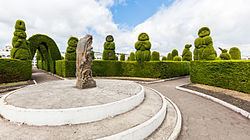Country Mayor Julio Robles | Area 138.75 km2 | |
 | ||
Tulcán is the capital of the province of Carchi in Ecuador. The population of Tulcán is approximately 60,400. Tulcán is known for its hot springs, deep wells, and a 3-acre topiary garden cemetery, the most elaborate topiary in the New World, created in Cupressus sempervirens by José Maria Azael Franco in 1936. The city is the highest in Ecuador, at 2,950 m (9,680 ft) above sea level.
Contents
Map of Tulcán
Etymology

The name is a Spaniard derivation of the indigenous peoples' original name Hul-Can, which in Mayan means "Warrior".
History

The known history of the aboriginal occupants of this lands begins with the conquest of the Incas, who never definitively conquered this people. The Spanish, seeking gold, became interested in the Quillasinga (the name given to the land), meaning "Gold Noses". Quillasinga was named without distinction of the ethnic occupants including the Pastos. Upon assuming the sovereignty for the Spanish crown, the territory was divided into provinces: Quillasinga road to Quito, Quillasinga road to Popayan, Quillasinga road to Almaguer, and Quillasinga road of the mountains. Tulcan's foundation is said to have been on June 11, 1535. With the arrival of colonists and further Spanish conquistadors, its growth increased and immediately passed to serve the Township of Otavalo, until 1600 when it passed to the township of Ibarra.
During the colonial age it remained under the authority of the Real Audiencia de Quito, in which it increased its economic importance, until it became the most significant locality in the region.
Independence
Independence movements and proclamations sparked through the region. The independence movement in Carchi was led by Alejandro Ruano, Antonio Baca, Cecilio Arciniegas, Esteban Baca, Leandro Campiño, José María Pava, Antonio Rueda, and Ramón Montenegro. On April 14, 1814 with charges of conspiracy of fighting for independence, these men were shot in Bolivar. The population continued its rebellion and in 1820, it ratified the Declaration of Independence of 9 de Octubre. Upon Ecuador becoming a republic, Tulcán retained its importance because it became a border town.
Proximity to Colombia
Tulcán is just 7 km (4.3 mi) from the Colombian border; the international bridge Rumichaca is shared by the two countries. Tulcán is bounded on the north by the municipality of Ipiales (Colombia), on the south by the Huaca Canton, to the east by the Amazonian provinces of Sucumbios and to the west by the coastal province of Esmeraldas.
This city is known for its civic culture and modern business, similar to that of Colombia because of its proximity to and significant trade with that country.
Climate
Tulcán features a Mediterranean climate (Csb) under Koppen classification.
Transportation
Tulcán is very well connected in terms of land and air transport: the Panamerican Highway and Luis A. Mantilla airport are located nearby.
